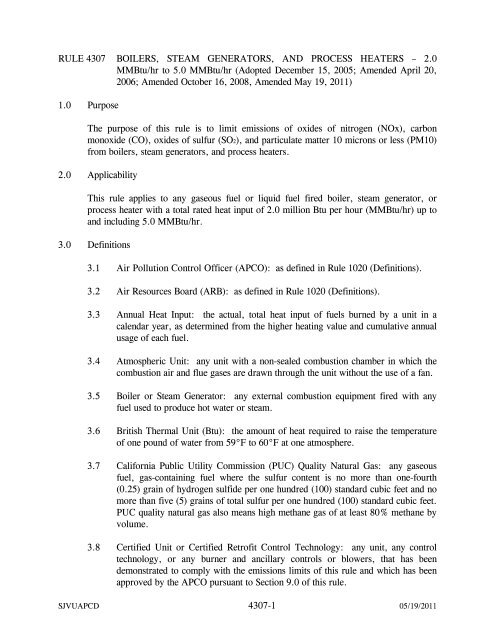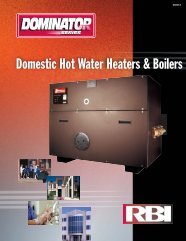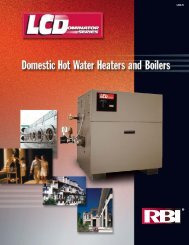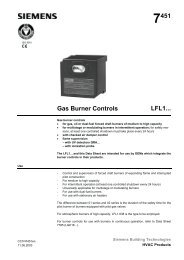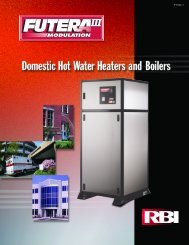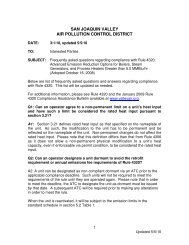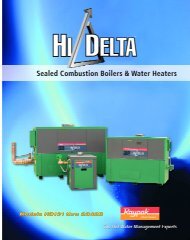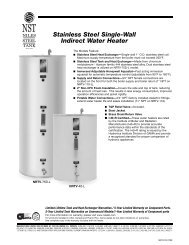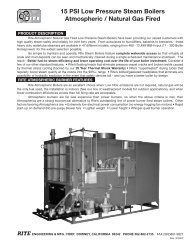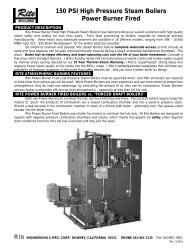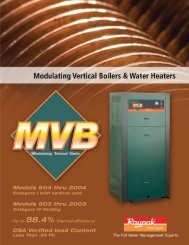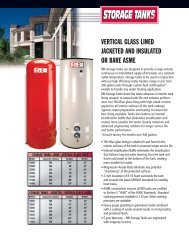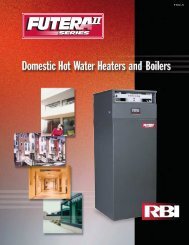Rule 4307 - San Joaquin Valley Air Pollution Control District
Rule 4307 - San Joaquin Valley Air Pollution Control District
Rule 4307 - San Joaquin Valley Air Pollution Control District
- No tags were found...
You also want an ePaper? Increase the reach of your titles
YUMPU automatically turns print PDFs into web optimized ePapers that Google loves.
RULE <strong>4307</strong> BOILERS, STEAM GENERATORS, AND PROCESS HEATERS – 2.0MMBtu/hr to 5.0 MMBtu/hr (Adopted December 15, 2005; Amended April 20,2006; Amended October 16, 2008, Amended May 19, 2011)1.0 PurposeThe purpose of this rule is to limit emissions of oxides of nitrogen (NOx), carbonmonoxide (CO), oxides of sulfur (SO2), and particulate matter 10 microns or less (PM10)from boilers, steam generators, and process heaters.2.0 ApplicabilityThis rule applies to any gaseous fuel or liquid fuel fired boiler, steam generator, orprocess heater with a total rated heat input of 2.0 million Btu per hour (MMBtu/hr) up toand including 5.0 MMBtu/hr.3.0 Definitions3.1 <strong>Air</strong> <strong>Pollution</strong> <strong>Control</strong> Officer (APCO): as defined in <strong>Rule</strong> 1020 (Definitions).3.2 <strong>Air</strong> Resources Board (ARB): as defined in <strong>Rule</strong> 1020 (Definitions).3.3 Annual Heat Input: the actual, total heat input of fuels burned by a unit in acalendar year, as determined from the higher heating value and cumulative annualusage of each fuel.3.4 Atmospheric Unit: any unit with a non-sealed combustion chamber in which thecombustion air and flue gases are drawn through the unit without the use of a fan.3.5 Boiler or Steam Generator: any external combustion equipment fired with anyfuel used to produce hot water or steam.3.6 British Thermal Unit (Btu): the amount of heat required to raise the temperatureof one pound of water from 59°F to 60°F at one atmosphere.3.7 California Public Utility Commission (PUC) Quality Natural Gas: any gaseousfuel, gas-containing fuel where the sulfur content is no more than one-fourth(0.25) grain of hydrogen sulfide per one hundred (100) standard cubic feet and nomore than five (5) grains of total sulfur per one hundred (100) standard cubic feet.PUC quality natural gas also means high methane gas of at least 80% methane byvolume.3.8 Certified Unit or Certified Retrofit <strong>Control</strong> Technology: any unit, any controltechnology, or any burner and ancillary controls or blowers, that has beendemonstrated to comply with the emissions limits of this rule and which has beenapproved by the APCO pursuant to Section 9.0 of this rule.SJVUAPCD <strong>4307</strong>-1 05/19/2011
3.9 Dryer: any unit in which material is dried in direct contact with the products ofcombustion.3.10 Gaseous Fuel: any fuel which is a gas at Standard Conditions.3.11 Heat Input: the heat (hhv basis) released due to fuel combustion in a unit, notincluding the sensible heat of incoming combustion air and fuel.3.12 Higher Heating Value (hhv): the total heat liberated per mass of fuel burned(expressed as Btu per pound), when fuel and dry air at standard conditionsundergo complete combustion and all resulting products are brought to theirstandard states at standard conditions.3.13 Humidifier: a device or system that uses an air stream heated by a direct contactcombustion process in combination with a water spray to produce warm air ofhigh humidity in order to maintain or increase the moisture content of thematerial being processed or conveyed by the air stream.3.14 Liquid Fuel: any fuel which is a liquid at Standard Conditions.3.15 NOx Emissions: the sum of oxides of nitrogen expressed as NO2 in the flue gas.3.16 NOx Exhaust <strong>Control</strong>: a device or technique used to treat a unit’s exhaustcombustion gas to reduce NOx emissions. Such a device or technique includes,but is not limited to, selective catalytic reduction or nonselective catalyticreduction.3.17 Parts Per Million by Volume (ppmv): as defined in <strong>Rule</strong> 1020 (Definitions).3.18 Process Heater: any combustion equipment fired with liquid and/or gaseous fueland which transfers heat from combustion gases to water or process streams. Thisdefinition excludes: kilns or ovens used for drying, baking, cooking, calcining, orvitrifying; and unfired waste heat recovery heaters used to recover sensible heatfrom the exhaust of combustion equipment.3.19 Qualified Technician: a stationary source employee or any personnel contractedby a stationary source operator who has a documented training and a demonstratedexperience performing tune-ups on a unit to the satisfaction of the APCO. Thedocumentation of tune-up training and experience shall be made available to theAPCO upon request.3.20 Rated Heat Input (expressed as million Btu per hour): the heat input capacityspecified on the nameplate of the unit. If the unit has been physically modifiedsuch that its maximum heat input differs from what is specified on the nameplate,SJVUAPCD <strong>4307</strong>-2 05/19/2011
the modified maximum heat input shall be considered as the rated heat input andmade enforceable by Permit to Operate.3.21 Re-ignition: the relighting of a unit after an unscheduled and unavoidableinterruption or shut off of the fuel flow or electrical power, for a period of lessthan 30 minutes, due to reasons outside the control of the operator.3.22 School: any public or private school used for the purpose of education andinstruction of school pupils in Kindergarten through Grade 12, but does notinclude any private school in which education and instruction are primarilyconducted in private homes.3.23 Shutdown: the period of time during which a unit is taken from an operational toa non-operational status by allowing it to cool down from its operatingtemperature to a cold or ambient temperature as the fuel supply is turned off. Aunit is considered in shutdown status when the fuel supply to the unit is turned offfor a continuous period of at least 30 minutes.3.24 Solid Fuel: any fuel which is a solid at Standard Conditions.3.25 Standard Conditions: as defined in <strong>Rule</strong> 1020 (Definitions).3.26 Start-up: the period of time during which a unit is brought from a shutdown statusto its operating temperature and pressure.3.27 Stationary Source: as defined in <strong>Rule</strong> 2201 (New and Modified Stationary SourceReview <strong>Rule</strong>).3.28 Tree Nut Pasteurizer: a unit, designed to remove pathogens from tree nuts, whichis operated at a tree nut processing facility subject to any part of Title 7 Section900 through 999 of the Code of Federal Regulations (7 CFR 900 through 7 CFR999).3.29 Unit: any boiler, steam generator or process heater as defined in this rule.3.30 US Environmental Protection Agency (EPA): the United States EnvironmentalProtection Agency or any person authorized to act on its behalf.4.0 ExemptionsThis rule shall not apply to:4.1 Solid fuel fired units.4.2 Dryers and glass melting furnaces.SJVUAPCD <strong>4307</strong>-3 05/19/2011
4.3 Kilns, humidifiers, and smelters where the products of combustion come intodirect contact with the material to be heated.4.4 Unfired or fired waste heat recovery boilers that are used to recover or augmentheat from the exhaust of combustion turbines or internal combustion engines.4.5 Units used at a school. On and after July 1, 2015, units used at a school shallcomply with all applicable requirements of this rule.4.6 The requirements of Section 5.1 shall not apply to a unit when burning any fuelother than PUC quality natural gas during a PUC quality natural gas curtailmentprovided all of the following conditions are met:5.0 Requirements4.6.1 Fuels other than PUC quality natural gas are burned no more than 168cumulative hours in a calendar year plus 48 hours per calendar year forequipment testing, as limited by Permit to Operate or Permit-ExemptEquipment Registration.4.6.2 NOx emission shall not exceed 150 ppmv (corrected to 3.00 percentoxygen) or 0.215 lb/MMBtu. Demonstration of compliance with this limitshall be made by either source testing, continuous emission monitoringsystem (CEMS), an APCO approved Alternate Monitoring System, or anAPCO approved portable NOx analyzer.All ppmv emission limits specified in this section are referenced at dry stack gasconditions and 3.00 percent by volume stack gas oxygen. Emission concentrations shallbe corrected to 3.00 percent oxygen in accordance with Section 8.1.5.1 NOx and CO Emission Limits5.1.1 Except for units subject to either Section 5.1.2 or Section 5.2, no unit shallbe operated unless it is certified, according to Section 9.0, or source testedin accordance with the test methods in Section 6.2, to comply with theapplicable emission limits specified in Table 1 and Table 2.Type of UnitGaseous Fuel-Fired UnitLiquid Fuel-Fired UnitTable 1 NOx and CO limitsNOx Limit30 ppmv or0.036 lb/MMBtu40 ppmv or0.052 lb/MMBtuCO Limit(ppmv)400400SJVUAPCD <strong>4307</strong>-4 05/19/2011
I. Atmospheric UnitsTable 2 NOx and CO limits for New and Replacement UnitsType of UnitA. A new or replacement unit that is notincluded in Section I. B.B. A new or replacement unit that is oneof the following:1. a unit used at a school; or2. a unit in an oilfield or refinery; or3. a glycol reboiler; or4. a unit with a heat input greater than1.8 billion Btu but less than 5.0billion Btu per calendar yearII.Non-Atmospheric UnitsType of UnitA. A new or replacement unit that is notincluded in Section II. B.B. A new or replacement unit that is one ofthe following:1. a unit used at a school; or2. a unit in an oilfield or refinery; or3. a glycol reboiler; or4. a unit with a heat input greater than1.8 billion Btu but less than 5.0billion Btu per calendar yearNOx Limit12 ppmv or0.014 lb/MMBtu12 ppmv or0.014 lb/MMBtuNOx Limit9 ppmv or0.011 lb/MMBtu9 ppmv or0.011 lb/MMBtuCO Limit(ppmv)400400CO Limit(ppmv)400400Effective DateUpon Installationof a new orreplacement uniton and afterJanuary 1, 2010Upon Installationof a new orreplacement uniton and afterJanuary 1, 2016Effective DateUpon Installationof a new orreplacement uniton and afterJanuary 1, 2010Upon Installationof a new orreplacement uniton and afterJanuary 1, 20165.1.2 Tree nut pasteurizers shall be fired exclusively on PUC quality natural gas.5.1.2.1 All tree nut pasteurizers shall be operated and maintainedaccording to manufacturer’s specifications or APCO-approvedalternative procedures.5.1.2.2 Operation and maintenance records and manufacturer’sspecifications/APCO-approved alternative procedures shall bemaintained in accordance with Section 6.1.5.SJVUAPCD <strong>4307</strong>-5 05/19/2011
5.1.2.3 During PUC quality natural gas curtailments, operators of treenut pasteurizers shall abide by the provisions of Section 4.6, ifthe unit is operated during the curtailment.5.2 Operators shall meet the following requirements as applicable.5.2.1 Until June 30, 2015, for each existing atmospheric unit operated in anoilfield or refinery; each glycol reboiler; or each unit limited to no morethan 5.0 billion Btu per calendar year heat input pursuant to a Permit toOperate or Permit-Exempt Equipment Registration, the operator shallcomply with Section 5.5.2, Section 7.3, Section 7.4, and either Section5.2.1.1, 5.2.1.2, or 5.2.1.3.5.2.1.1 Tune the unit at least twice per calendar year, (from four to eightmonths apart) using a qualified technician in accordance with theprocedure described in <strong>Rule</strong> 4304 (Equipment Tuning Procedurefor Boilers, Steam Generators, and Process Heaters). If the unitdoes not operate throughout a continuous six-month period withina calendar year, only one tune-up is required for that calendaryear. No tune-up is required for any unit that is not operatedduring that calendar year; this unit may be test fired to verifyavailability of the unit for its intended use, but once the test firingis completed the unit shall be shutdown; or5.2.1.2 Operate the unit in a manner that maintains exhaust oxygenconcentrations at less than or equal to 3.00 percent by volume ona dry basis; or5.2.1.3 Certify the unit according to Section 9.0 to comply with theapplicable emission requirements of Section 5.1 Table 1.5.2.2 On and after July 1, 2015, for each unit limited to no more than 1.8 billionBtu per calendar year heat input pursuant to a Permit to Operate or Permit-Exempt Equipment Registration, the operator shall comply with Section5.5.2, Section 7.3, Section 7.4, and either Section 5.2.1.1, 5.2.1.2, or5.2.1.3.5.2.3 On and after July 1, 2015, for each existing atmospheric unit in anoilfield or refinery; each glycol reboiler; or each unit with a heat inputgreater than 1.8 billion Btu to less than 5.0 billion Btu per calendar year,the operator shall comply with the applicable emission requirements ofSection 5.1 Table 1. The operator shall comply with the compliancerequirements and deadlines specified for Group 3 units in Section 7.1Table 3.SJVUAPCD <strong>4307</strong>-6 05/19/2011
5.3 Particulate Matter <strong>Control</strong> Requirements5.3.1 To limit particulate matter emissions, an operator shall comply with one ofthe following requirements:5.3.1.1 On and after July 1, 2015, operators shall fire units exclusivelyon PUC quality natural gas, commercial propane, butane,liquefied petroleum gas, or a combination of such gases; or5.3.1.2 On and after July 1, 2015, operators shall limit fuel sulfurcontent to no more than five (5) grains of total sulfur per onehundred (100) standard cubic feet; or5.3.1.3 On and after July 1, 2015, operators shall install and properlyoperate an emission control system that reduces SO2 emissionsby at least 95% by weight; or limit exhaust SO2 to less than orequal to 9 ppmv corrected to 3.0% O2.5.3.2 On and after July 1, 2015, liquid fuel shall be used only during a PUCquality natural gas curtailment period provided it contains no more than15 ppm sulfur as determined by the test method specified in Section 6.2.7.An operator shall comply with the recordkeeping requirement of Section6.1.3. In lieu of testing the sulfur content of liquid fuel, an operator maydemonstrate compliance with the 15 ppm sulfur content by obtaining acopy of the fuel sulfur content specification data from the fuelmanufacturer or vendor.5.4 Start-Up and Shutdown RequirementsThe applicable emission limits of Sections 5.1 and 5.2.1.2 shall not apply duringstart-up or shutdown provided an operator complies with the requirementsspecified below.5.4.1 For units not equipped with a NOx exhaust control, the duration of eachstart-up and each shut down shall not exceed one hour, except as providedin Section 5.4.4.5.4.2 For units equipped with a NOx exhaust control, the duration of eachstart-up and each shut down shall not exceed two hours, except asprovided in Section 5.4.4.5.4.3 The emission control system shall be in operation and emissions shall beminimized insofar as technologically feasible during start-up or shutdown.5.4.4 The APCO, ARB, and EPA may approve a longer start-up or shutdownduration than the duration specified in Section 5.4.1 or 5.4.2 (asSJVUAPCD <strong>4307</strong>-7 05/19/2011
applicable), if an operator submits an application for a Permit to Operateor Permit-Exempt Equipment Registration which provides a justificationfor the requested additional duration.5.4.4.1 The maximum allowable duration of start-up or shutdown will bedetermined by the APCO, ARB, and EPA.5.4.4.2 At a minimum, a justification for increased start-up or shutdownduration shall include the following:5.4.4.2.1 A clear identification of the control technologies orstrategies to be utilized; and5.4.4.2.2 A description of what physical conditions prevailduring start-up or shutdown periods that prevent thecontrols from being effective; and5.4.4.2.3 A reasonably precise estimate as to when thephysical conditions will have reached a state thatallows for the effective control of emissions; and5.4.4.2.4 A detailed list of activities to be performed duringstart-up or shutdown and a reasonable explanationfor the length of time needed to complete eachactivity; and5.4.4.2.5 A description of the material process flow rates andsystem operating parameters, etc., the operatorplans to evaluate during the process optimization;and an explanation of how the activities and processflow affect the operation of the emissions controlequipment; and5.4.4.2.6 Basis for the requested additional duration of startupor shutdown.5.4.5 Permit to Operate (PTO) changes solely to include start-up or shutdownconditions may be exempt from Best Available <strong>Control</strong> Technology(BACT) and emission offset requirements if the PTO changes meet therequirements of <strong>Rule</strong> 2201 (New or Modified Stationary Source Review<strong>Rule</strong>) Section 4.2 (BACT Exemptions) and <strong>Rule</strong> 2201 Section 4.6 (OffsetExemptions).SJVUAPCD <strong>4307</strong>-8 05/19/2011
5.5 Monitoring Provisions5.5.1 For units subject to the emission limits of Section 5.1 the operator shall;5.5.1.1 Monitor, at least once a month, the operational characteristicsrecommended by the manufacturer and approved by the APCO;and5.5.1.2 Tune the unit at least twice per calendar year, (from four toeight months apart) using a qualified technician in accordancewith the procedure described in <strong>Rule</strong> 4304 (Equipment TuningProcedure for Boilers, Steam Generators, and Process Heaters).If the unit does not operate throughout a continuous six-monthperiod within a calendar year, only one tune-up is required forthat calendar year. No tune-up is required for any unit that isnot operated during that calendar year; this unit may be testfired to verify availability of the unit for its intended use, butonce the test firing is completed the unit shall be shutdown. Inlieu of tuning the unit, operators shall monitor the emissions witha portable NOx analyzer and adjust the unit’s operatingparameters accordingly to assure compliance with the emissionlimits of this rule.5.5.2 The operator of any unit limited to the annual heat input specified inSection 5.2.1 or Section 5.2.2 shall install and maintain an operationalnon-resettable, totalizing mass or volumetric flow meter in each fuel lineto each unit. Volumetric flow measurements shall be periodicallycompensated for temperature and pressure. A master meter, whichmeasures fuel to all units in a group of similar units, may satisfy theserequirements if approved by the APCO in writing. The cumulativeannual fuel usage may be verified from utility service meters, purchaseor tank fill records, or other acceptable methods, as approved by theAPCO.5.5.3 Monitoring SOx Emissions5.5.3.1 Operators complying with Section 5.3.1.3 by installing andoperating a control device with 95% SOx reduction shallpropose the key system operating parameters and frequency ofthe monitoring and recording. The monitoring optionproposed shall be submitted for approval by the APCO.5.5.3.2 Operators complying with Sections 5.3.1.1 or 5.3.1.2 shallprovide an annual fuel analysis to the <strong>District</strong> unless a morefrequent sampling and reporting period is included in thePermit To Operate or Equipment Registration condition.SJVUAPCD <strong>4307</strong>-9 05/19/2011
5.6 Compliance DeterminationSulfur analysis shall be performed in accordance with the testmethods in Section 6.2.5.6.1 For the purposes of certification, the operator of any unit shall have theoption of demonstrating compliance with either the applicable heat inputemission limits (lb/MMBtu) or the concentration emission limits (ppmv)specified in Section 5.1. The emission limits selected to demonstratecompliance shall be specified in the Permit to Operate or Permit-ExemptEquipment Registration. The emission limit selected in Section 5.1 shallalso be specified in the source test proposal pursuant to <strong>Rule</strong> 1081 (SourceSampling).5.6.2 All emissions measurements shall be made with the unit operating either atconditions representative of normal operations or conditions specified inthe Permit to Operate or Permit-Exempt Equipment Registration.5.6.3 Unless otherwise specified in the Permit to Operate or Permit-ExemptEquipment Registration no determination of compliance shall beestablished within two hours after a continuous period in which fuel flowto the unit is shut off for 30 minutes or longer, or within 30 minutes after are-ignition as defined in Section 3.0.5.6.4 Notwithstanding the requirements of Section 5.6.3, for units with acyclical firing period that routinely interrupts fuel flow as part of itsnormal operation, source testing may commence sooner than specified inSection 5.6.3 and continue through its normal cyclical firing period.5.6.5 For emissions source testing performed pursuant to Section 6.3.1 for thepurpose of determining compliance with an applicable standard ornumerical limitation of this rule, the arithmetic average of three (3) 30-consecutive-minute test runs shall apply. If two (2) of three (3) runs areabove an applicable limit the test cannot be used to demonstratecompliance with an applicable limit.6.0 Administrative Requirements6.1 RecordkeepingThe records required by Sections 6.1.1 through 6.1.5 shall be maintained, andretained for five calendar years. The records shall be made available to theAPCO, ARB, and EPA upon request. Failure to maintain records or informationcontained in the records that demonstrates noncompliance with the applicablerequirements of this rule shall constitute a violation of this rule.SJVUAPCD <strong>4307</strong>-10 05/19/2011
6.1.1 The operator of any unit limited to the annual heat input specified inSection 5.2.1 or Section 5.2.2 shall record the amount of fuel use, atleast once a month for each unit, or for a group of units as specified inSection 5.5.2. On and after the compliance schedule specified in Section7.0 Table 3, any unit that exceeds the annual heat input limit specified inSection 5.2.1 or Section 5.2.2, shall be brought into full compliance withthis rule as specified in Section 7.3.6.1.2 The operator of any unit subject to the applicable requirements of Sections5.2.1.1, 5.5.1.1, and 5.5.1.2 shall maintain records to verify that tune-upand monitoring of the operational characteristics of the unit have beenperformed.6.1.3 Operators who operate a unit on liquid fuel during PUC-quality natural gascurtailment period shall record the sulfur content of the fuel, amount offuel used, and duration of the natural gas curtailment period.6.1.4 The operator performing start-up or shutdown of a unit shall keep recordsof the duration of start-up or shutdown that exceed the applicablerequirements of Sections 5.4.1 or 5.4.2.6.1.5 Tree Nut Pasteurizers Operations and Maintenance RecordsThe operator of a tree nut pasteurizer shall maintain operation andmaintenance records that demonstrate operation of the tree nutpasteurizer is within the limits of the manufacturer’s specification andmaintenance according to manufacturer’s recommendation or APCOapprovedalternative procedures.6.1.5.1 Operations records shall be maintained for the days on whichthe tree nut pasteurizer is operated.6.1.5.2 The operator shall keep maintenance records that verify thatmaintenance was performed in accordance with manufacturer’sspecifications or APCO-approved alternative procedures.6.1.5.3 A copy of the manufacturer’s operation specifications andmaintenance instruction manual or APCO-approved alternativeprocedures shall be maintained on-site during normal businesshours.6.1.5.4 If the manufacturer’s operation specifications or maintenanceinstruction manual are not available, the operator of a tree nutpasteurizer shall submit alternative operation or maintenanceprocedures for approval by the APCO by November 1, 2011 orSJVUAPCD <strong>4307</strong>-11 05/19/2011
6.2 Test Methodsas part of the Authority to Construct application, whichever islater.6.1.5.5 The operator of a tree nut pasteurizer shall maintain records thatdemonstrate that the fuel used to fire the pasteurizer is PUCquality natural gas.The following test methods shall be used unless otherwise approved by the APCO,ARB, and EPA.6.2.1 Oxides of nitrogen (ppmv) – EPA Method 7E, or ARB Method 100.6.2.2 Carbon monoxide (ppmv) – EPA Method 10, or ARB Method 100.6.2.3 Stack gas oxygen – EPA Method 3 or 3A, or ARB Method 100.6.2.4 NOx Emission Rate (Heat Input Basis) – EPA Method 19.6.2.5 Stack gas velocities – EPA Method 2.6.2.6 Stack gas moisture content – EPA Method 4.6.2.7 Sulfur content of liquid fuel – American Society for Testing and Materials(ASTM) D 6920-03 or ASTM D 5453-99.6.2.8 Determination of total sulfur as hydrogen sulfide (H2S) content – EPAMethod 11 or EPA Method 15, as appropriate.6.2.9 Oxides of sulfur – EPA Method 6C, EPA Method 8, or ARB Method 100.6.2.10 The SOx emission control system efficiency shall be determined using thefollowing:% <strong>Control</strong> Efficiency = [ (CSO2, inlet – CSO2, outlet) / CSO2, inlet ] X 100Where:CSO2, inlet = concentration of SOx (expressed as SO2) at the inlet side ofthe SOx emission control system, in lb/dscfCSO2, outlet = concentration of SOx (expressed as SO2) at the outlet sideof the SOx emission control system, in lb/dscfSJVUAPCD <strong>4307</strong>-12 05/19/2011
6.3 Compliance Demonstration6.3.1 The operator shall conduct an initial source test at the time of installationand/or modification for each non-certified unit or each non-certifiedretrofit control technology to demonstrate compliance with the applicablecertification emission limits in Section 5.1. Units demonstratingcompliance are eligible for certification under the provisions of Section9.0.6.3.2 Source testing of a certified unit or certified retrofit control technology, asdefined in Section 3.0, is not required provided the operator complies withthe requirements of Sections 6.3.2.1 and 6.3.2.2.6.3.2.1 Operate the unit within range of operating parameters specifiedin the APCO-approved certification document.6.3.2.2 Operate and maintain the unit in accordance with themanufacturer’s instructions and conditions specified in theAPCO-approved certification document.6.3.3 A unit or retrofit control technology that loses its certification status shallbe source tested within 60 days after the date the certification status is lostto demonstrate compliance with the emission limits of this rule. Themanufacturer or operator may request re-certification of a unit or retrofitcontrol technology that lost its certification status provided the provisionsof Section 9.0 are met.6.4 Equipment Registration Requirement7.0 Compliance ScheduleExcept for units that require a Permit to Operate pursuant to <strong>Rule</strong> 2020(Exemptions), the operator shall register with the <strong>District</strong> any unit subject to thisrule no later than the applicable date shown in Table 3, in accordance with <strong>Rule</strong>2250 (Permit-Exempt Equipment Registration).7.1 An operator with multiple units at a stationary source shall comply with this rule inaccordance with the schedule specified in Table 3. An operator with only one unitat a stationary source shall comply with the schedule specified in Table 3, Group 2.SJVUAPCD <strong>4307</strong>-13 05/19/2011
Quantity of Units to be inCompliance at a StationarySourceTABLE 3 - Compliance ScheduleAuthority toConstructPermit-ExemptEquipmentRegistrationFull ComplianceGroup 1:50% or more of the totalnumber of units subject to this January 1, 2008 April 1, 2008 July 1, 2008rule on July 1, 2008, excludingGroup 3Group 2:100% of the total number ofunits subject to this rule on and January 1, 2009 April 1, 2009 July 1, 2009after July 1, 2009, excludingGroup 3Group 3:100%of the total number ofunits subject to Section 5.2.3and 100% of the total number January 1, 2015 April 1, 2015 July 1, 2015of units located at a school,subject to this rule on and afterJuly 1, 2015Units are considered to be subject to this rule if the rule is applicable to the units pursuantto Section 2.0 and the units are not exempt pursuant to Section 4.0.7.2 As shown in Table 3, the column labeled:7.2.1 “Authority to Construct” identifies the date by which the operator shallsubmit an Application for Authority to Construct for each unit subject tothis rule and which is required to have a Permit to Operate (PTO) pursuantto <strong>Rule</strong> 2020 (Exemptions).7.2.2 “Permit-Exempt Equipment Registration” identifies the date by which theowner or operator shall submit a complete Permit-Exempt EquipmentRegistration application for each unit subject to the registrationrequirements of <strong>Rule</strong> 2250 (Permit-Exempt Equipment Registration).7.2.3 "Full Compliance" identifies the date by which the owner shall demonstratethat each unit is in compliance with this rule regardless of whether the unitrequires a Permit to Operate or a Permit-Exempt Equipment Registration.7.3 Any unit that becomes subject to the emission limits of this rule as a result ofexceeding the annual heat input limit specified in Section 5.2.1 or Section 5.2.2,shall be in compliance with the emission limits specified in Section 5.1 Table 1 onand after the date the annual heat input limit is exceeded.SJVUAPCD <strong>4307</strong>-14 05/19/2011
7.4 When an existing unit, that is subject to Section 5.2, is replaced, the replacementunit shall be certified, according to Section 9.0, or source tested in accordance withthe test methods in Section 6.2 to comply with the applicable emission limitsspecified in Section 5.1, on and after the date of initial operation.8.0 Calculations8.1 All ppmv emission limits specified in Section 5.1 are referenced at dry stack gasconditions and 3.00 percent by volume stack gas oxygen. Emission concentrationsshall be corrected to 3.00 percent oxygen as follows:[17.95%20.95% − [% O2]ppm NOx]corrected =x [ ppm NOx]measuredmeasured[17.95%20.95% − [% O2]ppm CO]corrected =x [ ppmCO]measuredmeasured8.2 All pounds per million Btu NOx emission rates shall be calculated as pounds ofnitrogen dioxide per million Btu of heat input (hhv).9.0 Equipment Certification Requirements9.1 To be considered for APCO certification, the manufacturer or operator shallcomply with the following requirements:9.1.1 Certification shall be based upon the emission source testing results of aspecific unit, or a randomly selected unit of each model, or retrofit controltechnology.9.1.2 A source testing protocol shall be submitted in accordance with theprovisions of <strong>Rule</strong> 1081 (Source Sampling) for approval by the APCOprior to conducting the source test. The source testing protocolapproved by the APCO shall be strictly adhered to during certificationsource testing.9.1.3 Source testing shall be conducted over the range of operating parametersfor which the unit(s) or retrofit control technology will be operated.9.1.4 The source testing results shall demonstrate compliance with the emissionlimits of this rule for each model of unit(s), or retrofit control technologyto be certified.9.1.5 The source testing procedure and reports shall be prepared by an ARBapprovedindependent testing laboratory, and shall contain all the elementsidentified in the APCO-approved source testing protocol.SJVUAPCD <strong>4307</strong>-15 05/19/2011
9.1.6 Source testing shall be conducted no more than 90 days prior to the date ofsubmission of request for certification by the APCO.9.2 The manufacturer or operator requesting certification shall submit to the APCOthe following information:9.2.1 Copies of the source testing results conducted pursuant to the requirementsof Section 9.1, and other pertinent technical data to demonstratecompliance with the emission limits of this rule.9.2.2 The applicant shall sign and date the statement attesting to the accuracy ofall information in the statement.9.2.3 Name and address of the unit manufacturer or operator, brand name of theunit or retrofit control technology, model number, rated heat input as itappears in the unit nameplate, and description of model of unit(s), orretrofit control technology being certified.9.3 The APCO will only approve an application for certification to the extent that therequirements of Sections 9.1 through 9.2 are met and the source testing resultsdemonstrate that the emission limits of this rule are met.9.4 The APCO-approved certification is valid only for the range of operatingparameters for which certification is issued.9.5 A certified unit or a certified retrofit control technology that is operated outsidethe APCO-certified range of operating parameters shall lose its certification status.A unit or retrofit control technology that loses its certification status shall complywith the requirements of Section 6.3.3.9.6 The APCO shall publish a list of certified units or certified retrofit controltechnology after the certification process is completed.SJVUAPCD <strong>4307</strong>-16 05/19/2011


